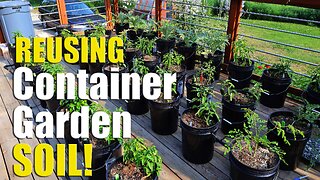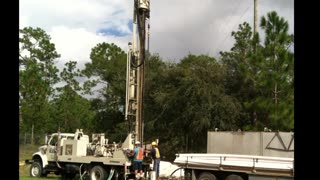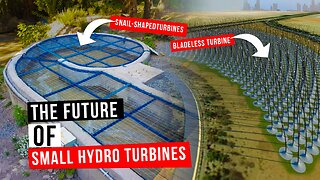New Desert machine harvest's 500L of water from the air in 1 minute
The dersert finally got its desired life. Have you ever wondered how we can quench the thirst of arid regions and tackle water scarcity in some of the world's most inhospitable environments? With the advancement of technology, scientists and engineers have been hard at work developing innovative solutions to harvest water from the desert's air. In this article, we will explore the groundbreaking methods and materials that are revolutionizing the way we extract this precious resource, providing hope for a sustainable future.
One remarkable development in the field of water harvesting is the creation of a new generation of machines that can generate water from the atmosphere. Watergen, a company initially acquired by a Russian investor, has been at the forefront of this technology. Their machines utilize a unique technique known as atmospheric water generation (AWG), which extracts water from the entire air mass. However, a new player in the field, H2oll, has taken the concept even further by introducing second-generation AWG machines that yield significantly higher water outputs.
These cutting-edge machines incorporate a superabsorbent hydrogel, a revolutionary material that has caught the attention of researchers at the Massachusetts Institute of Technology (MIT). This hydrogel has the remarkable ability to capture and retain large quantities of water vapor from the air, even in the most arid conditions. By leveraging the hygroscopic properties of the gel, scientists have achieved remarkable success in water extraction.
One of the key advancements in hydrogel technology is the development of a superabsorbent, salty hydrogel. This innovation, which was recently reported in the scientific journal Materials, has the potential to revolutionize water harvesting in desert regions. By incorporating salt into the hydrogel, researchers have significantly enhanced its water absorption capabilities. This means that even in extremely dry conditions, the hydrogel can draw moisture from the air and convert it into usable water.
The unique properties of this salty hydrogel stem from its ability to efficiently interact with water molecules in the surrounding environment. As the air passes through the hydrogel, the material's hygroscopic nature attracts and captures the water vapor, effectively pulling it out of the air. The captured water can then be released through a controlled process, providing a reliable and sustainable source of freshwater.
But how does this hydrogel compare to other water harvesting technologies? Traditional methods, such as condensation-based systems, often rely on cooling the air to reach the dew point, where water vapor condenses into liquid form. While effective, these systems can be energy-intensive and may not work optimally in arid climates. The superabsorbent hydrogel offers a more efficient alternative, as it can capture water vapor directly from the air without the need for extensive cooling processes.
Furthermore, the hydrogel's potential goes beyond water harvesting for human consumption. It can also be utilized for agricultural purposes, providing a sustainable irrigation solution for crops in desert regions. By extracting water from the air, this gel has the potential to transform barren landscapes into flourishing agricultural areas, bringing economic stability and food security to communities facing water scarcity.
In addition to the superabsorbent hydrogel, other materials have also emerged as promising solutions for harvesting water from the atmosphere. Organic crystals, for instance, have shown great potential in extracting moisture from the air. These crystals can undergo reversible changes in their structure, depending on the humidity level. As the air becomes more humid, the crystals swell and capture water vapor. Then, as the humidity decreases, the crystals release the water, ready for collection.
The development of these innovative materials and technologies has not only addressed the urgent need for water in arid regions but also holds promise for combating global water scarcity. As the world's population continues to grow, water resources are becoming increasingly strained. By harnessing the power of these advancements, we can tap into a virtually unlimited water source-the atmosphere -and alleviate the pressure on traditional water sources.
One of the significant advantages of harvesting water from the air is its potential for scalability. Unlike conventional water sources such as rivers, lakes, or underground aquifers, the atmosphere is accessible almost everywhere on the planet. This means that water can be extracted from the air in remote desert regions where traditional water infrastructure is limited or non-existent. The ability to generate water locally reduces dependence on long-distance transportation and allows communities to become more self-sufficient in meeting their water needs.
#waterharvesting #Desert #firstflix #airwater
-
 8:51
8:51
EcoDrive Tech
5 months agoWhy Salt Water may be the Future of Batteries
24 -
 12:54
12:54
Praxis Homesteading and Survival Skills
6 months agoGrowing Food in a Gray Water Powered Greenhouse
21 -
 8:08
8:08
EcoDrive Tech
2 months agoVertical Farming: The Future of Food is UP!
10 -
 6:32
6:32
Frosty Garden
8 months agoReusing Container Garden Soil & Winter Soil Storage Techniques
48 -
 9:02
9:02
LetsBoGrandon
6 months agoZERO WATER FILTRATION SYSTEMS. MAJOR CONCERNS: WHAT YOU NEED TO KNOW
5 -
 1:50
1:50
poakkweke
6 months agoWater Freedom System Review: A Guide to Produce Your Own Water To Drink
46 -
 4:22
4:22
ALLCHECKOUT
5 months agoSimPure Q3-600, Tankless Mini Reverse Osmosis Water Purifier, Unboxing
6 -
 2:06
2:06
itsallaboutthebiology
5 months agoIf You Irrigate You Need To Watch This Video!
40 -
 5:31
5:31
itsallaboutthebiology
3 months agoWorm Farm Moisture Content.
16 -
 8:49
8:49
EcoDrive Tech
1 month agoRevolutionizing Renewables: Can Small Hydro Turbines Power the World?
61